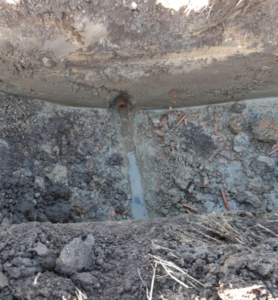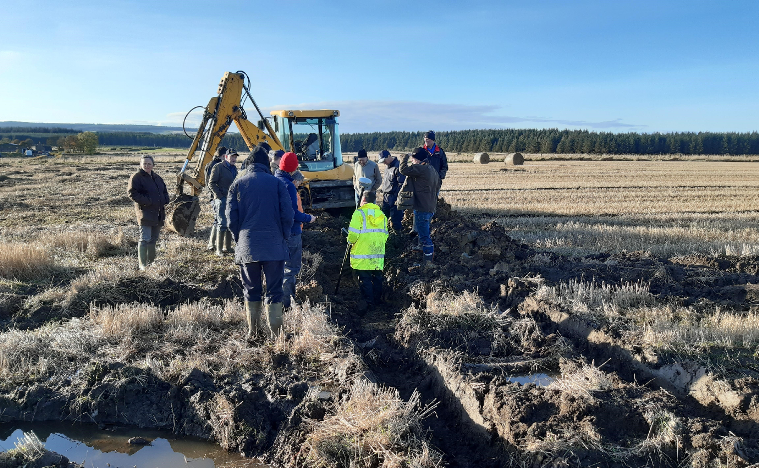Banffshire Soil & Nutrient Network: Final meeting – event summary
27 November 2019Field drainage was the primary focus of the final meeting for the Banffshire Soil & Nutrient Network.
The meeting was held on our host farm, Newmills of Boyne near Cornhill, and very kindly James Beattie allowed us to dig some deep holes in some of his fields to learn in the field about drainage problems and how these might be fixed. Soils & drainage expert Gavin Elrick was our main speaker during the event, and with his breadth of experience and knowledge was able to lead what was a great interactive event.
Field drainage is fundamental to farming, both crop production and livestock production. There has been little focus on this topic in recent years and, given the recent wet weather experienced in the area and the difficulty in harvesting crops, establishing winter cereals etc., there is an increasing interest in how an effective drainage system can improve production. Many of the current drainage systems in place on Scottish farms were installed over 20 years ago and without maintenance are now starting to fail. When surface water indicates a problem or a VESS in the field shows signs of drainage problems more often than not, a bit of time and investment will offer a return with improved crop performance and yields, but this can take many years to balance out. It is important to take the health of the soil into consideration – as has been seen locally, the weather conditions are changing and fields that have ineffective drainage systems are more likely to incur damage from heavy machinery use, particularly if the soil structure is compromised by a failing drainage system.
The main focus for this event was in a field with some obvious signs of surface water. Gavin discussed the importance of outfall, accurate measurement of depth, gradients, the size of drainage pipe required, the different types of drainage pipes, pipe spacing and  crucially the importance of stone/gravel in any drainage system. Whilst stone can be a high cost in any drainage system, it’s inclusion helps to prevent drainage system failure due to clogged pipes and compaction around the drains which will prevent water from reaching the system; Gavin explained some of the ways that the quantity of stone can be reduced within a drainage system and how the soil type that is being drained can have an impact on the type of system installed.
crucially the importance of stone/gravel in any drainage system. Whilst stone can be a high cost in any drainage system, it’s inclusion helps to prevent drainage system failure due to clogged pipes and compaction around the drains which will prevent water from reaching the system; Gavin explained some of the ways that the quantity of stone can be reduced within a drainage system and how the soil type that is being drained can have an impact on the type of system installed.
During the event, an attempt was made to put a cost on the installation of a completely new drainage system for the field in question whilst also calculating what increase in crop yield would be required to pay for these works. However, it is important to remember that fields that are waterlogged will not only have reduced production capacity but become a potential diffuse pollution risk if fertilisers are applied – there is an increased risk of runoff, and plants may be unable to utilise all of the nutrients if the root systems are compromised. Beyond the environmental problems this can incur, there is a financial loss to the farmer when applied nutrients are ineffective.
Take-home messages:
- Make a note of areas of fields which show obvious signs of drainage problems, particularly during winter
- Examine soil structure – is there evidence of compaction or waterlogging at a particular depth?
- Check the drainage outlets – are they blocked and preventing the system working?
- Check the depth of the current drainage system and whether or not pipes have collapsed, or are the pipes simply too small?
- Consider the costs of installing a new system v the opportunity to add a secondary drainage system tapping into the main drains of the old system
- Although expensive, the use of stones/gravel in a drainage system can extend the life of it but preventing clogging and allowing water to quickly and easily run into the pipe network
A number of publications were available to take home from the event, these can be downloaded from the links at the bottom of this page.
If you have any concerns about drainage on your farm and would like further advice, contact the FAS helpline on 0300 323 0161 where you can be put in touch with an advisor for further guidance.
- Technical Note (TN720): Assessment for Agricultural Drainage Requirement
- This technical note examines drainage on agricultural land including the benefits, assessing for drainage, topography and possible issues.
- Farming For A Better Climate: Practical Guide – Field Drainage
- Topics: Soils and Water Management
- Practical Guide: Tyre Selection & Management
- This practical guide explains how to reduce soil damage, improve fuel usage and reduce overall green house gas emissions by selecting the correct tyre size, type and pressure.
- Topics: Climate Change
- Farming For A Better Climate: Practical Guide – Improving Soil Quality
- This Practical Guide concentrates on how we can improve soil quality to help us to adapt to climate change.
- Topics: Soils
- Visual Evaluation of Soil Structure (VESS) Score Chart
- This is a downloadable copy of the Visual Evaluation of Soil Structure (VESS) score chart for use in-field.
- Topics: Soils
- Valuing Your Soils – Practical Guidance for Scottish Farmers
- This brochure includes useful information about Scotland's agricultural soils and practical advice outlining the upfront financial savings and business benefits of better soil management and the efficient use of resources. Action and problem-specific 'field-sheets' are designed for busy farmers with limited time for reading.
- Topics: Climate Change, Soils, Water Management and Crops and Soils
- AHDB: Field Drainage Guide
- AHDB: Field Drainage Guide
- Topics: Climate Change, Soils, Crofts & Small Farms and Water Management
Sign up to the FAS newsletter
Receive updates on news, events and publications from Scotland’s Farm Advisory Service

